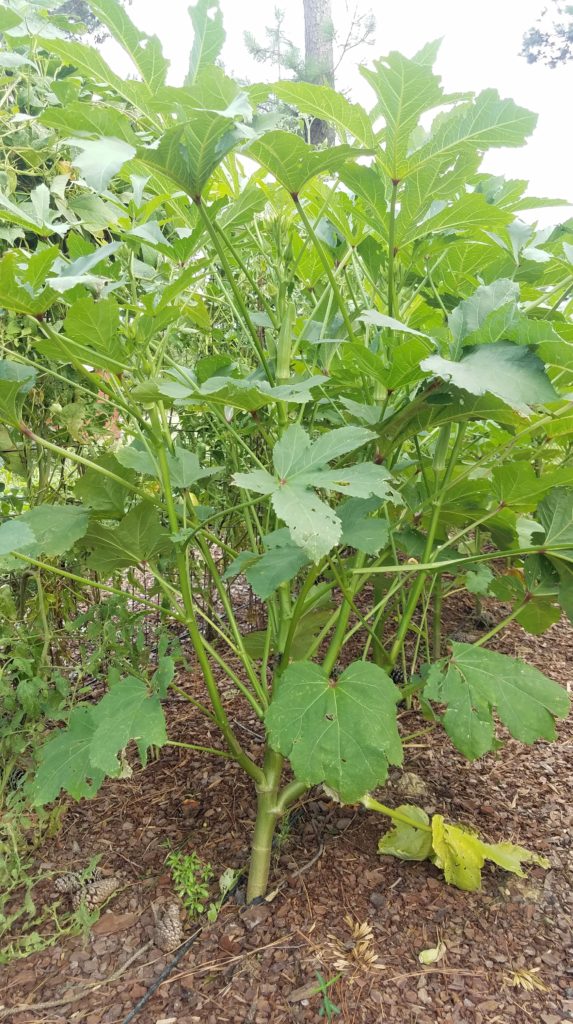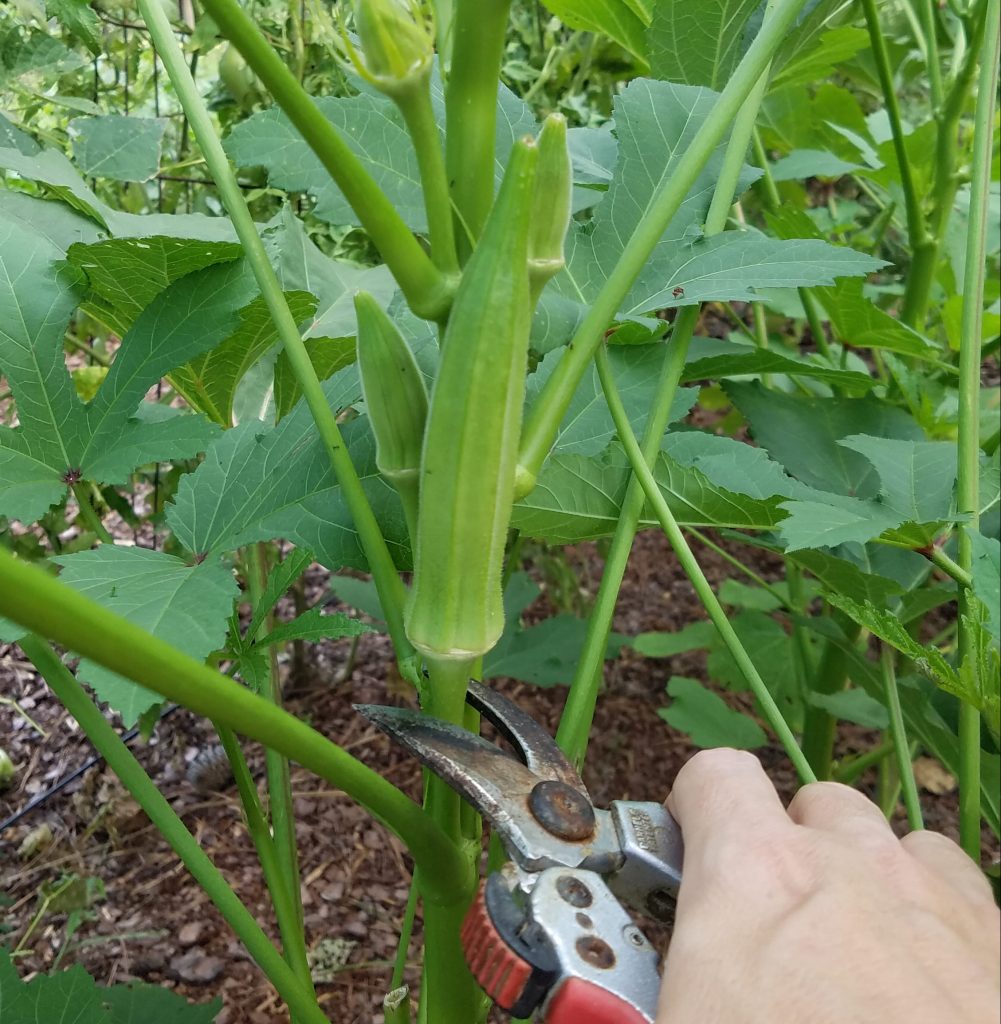How to Grow Okra in Your Garden or Raised Bed
Growing okra in my garden is one of my favorite vegetables to grow! And it’s not just for those of us who live in the southern US. With a little understanding of okra’s basic growing requirements, this tasty vegetable can be grown in most areas of the country. Plus, its versatility offers growing options of both raised beds and in the garden.
In this episode of the Beginner’s Garden Podcast and in the article below, you’ll learn how to grow okra either in your garden or raised bed — no matter where you live.
Planting Okra
While most people assume okra is only for southerners, you definitely can (and should!) grow okra even in the north. The key is soil and air temperature. You don’t want to plant until your soil is 75* — the warmer the better. Okra won’t grow in cool soil, and it will not grow well until daytime temperatures rise to around 90*. Understanding these ideal growing conditions for okra, I plant my seeds about a month after our last frost.
How to Grow Okra from Seeds
Personally, I only plant okra from seed. I haven’t had to buy okra seeds in seven years because it’s so easy to save these seeds! (Learn how to save okra seeds here.)
Sometimes people soak their seeds for faster germination. And since okra seeds are hard, some find success by nicking their seeds with something sharp to help them germinate, a process known as scarification.
What if you’re planting okra in a cooler, short-season climate? Joey and Holly Baird from the Wisconsin Vegetable Gardener shared their tips with me on growing okra in a cooler climate. They suggested soaking your seeds in milk overnight. The acid in the milk can break down the seed coating so they will germinate more quickly.

How to Plant Okra from Transplants
Can you plant okra from transplants? Yes, but you do need to keep in mind a few things.
The main thing you want to consider with transplants is that okra has a long taproot. Buy a smaller transplant so that the taproot has not reached the bottom of the pot. If you’re starting your okra seeds indoors, carefully time your sowing where you can transplant those small plants approximately one month after your last frost.
Transplants will be more helpful for gardeners cooler climates with shorter growing seasons. In my southern heat, it’s much easier to plant seeds directly in the ground.
How Much Okra to Plant and Plant Spacing Requirements
How many okra plants do you need, and how far apart should they be planted? I recommend starting with 2-4 plants and keeping them about 12″ apart. This is just an average; I plant about a dozen or more each season for my family and we eat okra twice per week during peak season.
Also keep in mind that if you’re in a cooler climate, your plants may not grow as tall as those of us with hotter summers. Because of this, your yield could be comparatively less; therefore, you might want to plant more.
In areas with hot summers, okra will get very tall. In your garden planning, consider this when planning what to plant around your okra so that you don’t have problems with the okra casting too much shade.
Growing Okra
Growing Okra in Raised Beds
What if you don’t have an in-ground garden? You can absolutely grow okra in your raised beds! But you need to be careful with the taproot and not plant them in a bed with an impermeable bottom layer, like landscape fabric or a new layer of cardboard. The taproot needs to have plenty of room to grow. The taproot of an okra plant can grow two to three feet deep.
Growing Okra in the Northern US
If you’re in a cooler climate with a shorter hot growing season, there are a few things you can do to have a more successful okra harvest. These ideas are also from the Wisconsin Vegetable Gardener. First, you’ll want to make sure that your soil is rich in nutrients. The more fertile your soil, the faster and better all of your crops will grow.
Companion Planting with Okra
Okra can grow very tall (mine are usually over seven feet tall), but the bottom of the plants are narrow. This offers plenty of room for a different crop to grow at the base of the okra. You can plant melons, squash, black eyed peas or bush beans under your okra. You could also grow pole beans up your okra!
How to Harvest Okra
Most of my harvest comes in July, August, and September. When the weather begins to cool, for me around the middle of September, the harvest begins to slow down.

I’ve noticed as the season goes on that it’s more important to pick the okra pods when they are very young. In the beginning of the season they can grow fairly large and still be tender, but towards the end of the season they get tough more quickly. Depending on the variety, you may have to harvest when the pods are 2-3″ but sometimes 4-5″ will still be good and tender.
When you start seeing flowers on your plants, get ready because your okra will be ready in just a few days.

One other tip: When you harvest, make sure to wear gloves that reach your elbows because okra leaves can cause irritation. You’ll also want to use clippers so that you do not damage your plant. In the heat of the summer, be ready to harvest every day. They produce very quickly and even waiting a day can make them too tough to eat.
Hopefully with these tips you’ll be well on your way to a fabulous okra harvest, no matter where you grow okra!
Do you get overwhelmed with garden planning?

Subscribe here for my best tips to plan your garden in just 7 days -- all for FREE.
Plus, I'll send you my "In the Garden E-mail" on Fridays, periodic updates on garden resources relevant to you, and you'll receive access to my entire bank of free garden downloads!
You are also agreeing to our privacy policy.


I like to freeze okra. If you toss it with just the cornmeal (and maybe other preferred spices) after slicing, spread it out on a cookie sheet, freeze it and then put it in a baggie. Keeps it separated and maintains the flavor 😉
When does orka stop making orka
Production slows down when temperatures start dipping into the low 80s. In my area, this is later in September and into October.
We get huge 7-8 foot tall plants on one main stem. The plant produces maybe 5 or 6 okra pods per plant. how can I get more okra pods per plant?
That’s a good question. First, I would enrich with compost. I notice I get more okra (and a fuller plant, not just taller) when the soil is more fertile. Second, you might try growing another variety. I found Clemson Spineless to outperform another variety I tried this year.
I don’t know if this is still active or not, but…
I have germinated some okra seeds using the paper towel method, soaking the seeds first.
They started to sprout, so I put them in peat pots, but the seeds won’t break from the sprouts and it’s stopping them from growing, actually killing my sprouts.
How can I get the seeds to break away from the sprouts?
Thanks!
I’ve never had this happen with okra, though I have seen it in tomatoes and peppers. Usually I’ll pinch or clip the seed off. From what I understand, this can happen with old seed, though I’ve seen it in newer seed, too, and I’m not sure what causes it. I don’t start okra seeds indoors — I directly sow them in the garden — so I’m not sure if that might have played a role?
Hi Tad,
The way I get my tomato and pepper seeds off is with spit, rubbing the seeded end between my fingers, which I’ve spit on. I know it sounds gross, but there is an enzyme in your saliva that breaks down the seed coat. It seems like it would work the same on an okra seed. I used to routinely lose a few tomatoes and peppers just because they couldn’t break free. This works! Good luck.
I live on zone 8A and we are having a cool spring this year so am waiting for tje weather to warm up to plenty okra…probably in mid April. By the 4th of July, I cut my okra plants in half so when they rebound, and theydo, they produce bountiful amounts of okra until november.
Can you explain more why you cut them back? I’m in 7b and I harvest until probably mid-October, depending on when it cools off. What benefit does cutting them back provide, that you’ve seen?
I’d like to know also. Thanks Jill for the great info!
HI. I subscribed and I’m not getting regular emails! Love this article on okra. This year will be my first try at growing it in Zone 7B
Hi Lois, I checked and it looks like you’re receiving the weekly emails I send on Fridays. If you don’t see them in your inbox, perhaps since you have a gmail address, they are under the “promotions” tab.
Just wanted to say, I found this so interesting that I was disapointed when I came to the end of the comments. LOL! Thank for the education. So many good tips. This will be my first time planting okra after a lifetime of loving it